 |
|

|
 |
TABLE of CONTENTS
 |
Many hands make sure population signs keep up with the times |
By Joseph Palmersheim
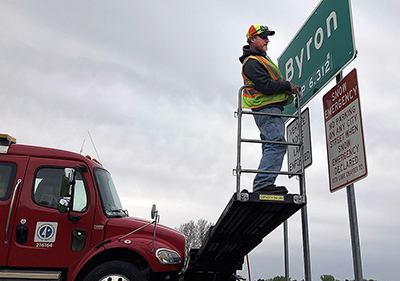
Loren Tews, District 6 Sign Shop worker, updates the population number for the city of Byron on May 17. The population increased nearly 28 percent since the last U.S. census in 2010. Photo by Mike Dougherty |
From Ada to Zumbrota, from the smallest (Kinbrae City, population 10) to the largest (Minneapolis, population 429,954), each Minnesota city along a MnDOT roadway has at least one sign with a population number that needs to be updated after a U.S. census.
MnDOT crews started changing more than 2,300 of these signs this spring, with work continuing into this summer. Depending on how old it is, a sign might get a new number plaque or be replaced entirely.
Updating numbers on these signs is a multi-step process involving several departments:
- District traffic offices get updated population numbers from the Minnesota State Demographic Center
- MnDOT staff members order new signs (or updated number plaques) from the State Sign Shop
- The State Sign Shop makes the new signs/plaques
- The sign shop sends them back out to district sign crews
- The sign crews do the actual sign changeover. The amount of time this takes can vary depending on crew workloads.
Population signs make up a small fraction of the 400,000 sign panels that MnDOT owns across the state. These aluminum signs are lighter and less prone to rust than their steel forbearers, and their coatings are specially designed to withstand years of ultraviolet light from the sun.
The average sign lasts about 15 years, said Josie Tayse, state sign engineer. Vehicle hits can also impact sign service life.
Even after it is taken down, though, a sign can live more than once. “If they have faded but the aluminum is still in good shape, we can strip off the sheeting — the film with letters and colors — and reuse a sign,” said Brad Lechtenberg, state striping coordinator and Sign Shop manager.
Cities can also choose to have their population number updated sooner than every 10 years if they are willing to pay for it. Some Minnesota cities do updates every five years. MnDOT requires an updated population number from an official source for this to happen.
These numbers are more than digits on a piece of metal. They sometimes tell part of the story of whatever city they are in.
“I know a lot of people are very proud of their city’s number, especially in the smaller cities,” Tayse said.
Lechtenberg agreed, adding that population signs are one of the most-requested signs from members of the public (after Hwy 61 sign requests from Bob Dylan fans everywhere).
“It’s hometown ownership,” he said. |
|

|
 |
TABLE of CONTENTS
 |
Jean Wallace to serve as interim deputy commissioner and chief engineer |
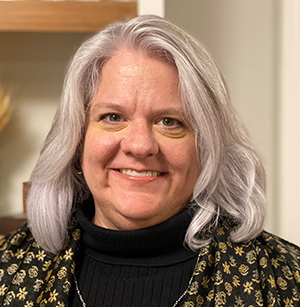
Jean Wallace is the interim deputy commissioner and chief engineer. Submitted photo |
After serving in various senior leadership roles for MnDOT over the last several years, Jean Wallace will be stepping into the role of interim deputy commissioner and chief engineer, starting June 22.
Most recently, Wallace assisted in leading the Modal Planning and Program Management Division, which is responsible for overseeing capital programming, asset management, statewide planning, research and the modal offices of MnDOT. She has held this position since August 2013, and she has been with MnDOT since November 2008. Prior to joining MnDOT, she worked with the Federal Highway Administration for more than 14 years in various roles including federal aid assignments in Wisconsin, Pennsylvania, Colorado and Minnesota; construction assignments in Mississippi and the Yukon Territory of Canada and a special assignment in FHWA’s International Programs Office in Washington, D.C.
Wallace has a Bachelor of Civil Engineering degree from the University of Minnesota and completed graduate studies in civil engineering with an emphasis in pavement design and materials, also at the University of Minnesota. She is a licensed civil engineer in Minnesota. She also has a master’s certificate in project management from the George Washington University and is a certified Project Management Professional from the Project Management Institute.
Wallace is native of Minnesota. She currently resides in Woodbury with her husband and daughter.
She will continue to provide leadership to the Modal Planning and Program Management Division, until a new director is identified to replace Assistant Commissioner Tim Henkel, who is retiring on July 5. |
|

|
 |
TABLE of CONTENTS
 |
Auto Show attendees are convinced of the importance of wearing their seat belt |
By Kristine Hernandez, Traffic Engineering, with assistance from TZD staff
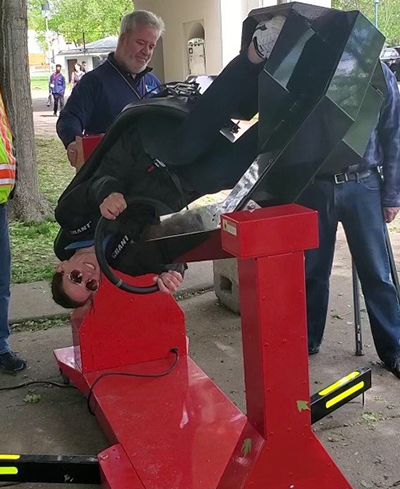
Tara Helm, West Metro TZD regional coordinator, tries out the seat belt persuader at the Twin Cities Auto Show. Photo by Kristine Hernandez |
More than 500 Minnesotans took a ride on two pieces of Toward Zero Deaths’ interactive equipment at this year’s Twin Cities Auto Show in May: the seat belt convincer and the seat belt persuader. This was the first time that TZD stakeholders were given complimentary space at the nine-day auto show to talk with attendees about traffic safety topics and highlight reasons why seat-belt use is so important while traveling in a vehicle.
“The equipment puts the emphasis on buckling up every time you get into the vehicle, whether as the driver or as a passenger, and in every seating position, whether in the front seat or the back seat,” said Tara Helm, West Metro TZD regional coordinator. “Wearing a seat belt is the simplest action you can take to prevent injury or death when traveling on roadways.”
“A lot of parents with teens, who are close to getting their driver’s license, wanted them to experience the equipment,” said Helm. “Even though the convincer is set for an impact of 10 miles per hour, it definitely shows the importance of wearing a seat belt.”
Seat Belt Convincer
The seat belt convincer simulates a very low speed crash. Riders safely experience how their seat belt keeps them secure and in-place inside the vehicle.
“Many people are surprised by how intense the jolt of the ‘crash’ feels when traveling at that speed,” said Scot Edgeworth, East Metro TZD regional coordinator. “One rider thought the convincer was going sixty miles per hour. He was very surprised to learn how seat belts protect you even at 10 miles per hour.”
Some attendees at the car show shared with volunteers that they don’t always wear their seat belt. Some of the excuses included: “I’m just driving through town at low speeds,” “It’ll wrinkle my shirt,” “I’m not traveling very far’” or simply “I forget to put it on.”
Seat belt persuader
The seat belt persuader lets people experience how a seat belt protects them when going through a rollover crash. The equipment rotates a person around at one mile per hour, while wearing a harness. When riders briefly dangle upside-down, they can feel that the only thing keeping them in place is the seat belt.
“The equipment gets your attention and proves how effective it is to wear a seat belt,” said Helm.
After the demonstration, riders were asked about what they thought would happen if they didn’t have their seat belt on. One man admitted that if he didn’t have his seat belt on, while traveling on the interstate at higher speeds, he’d likely be ejected – resulting in never seeing his daughter again. He then told his partner that he needs to start wearing his seat belt every time he gets in their car.
The complementary booth was staffed by nearly 30 TZD volunteers from MnDOT Metro District, Office of Traffic Engineering, the Metro TZD Regional Steering Committee, Metro TZD county coalition members and the Department of Public Safety’s Office of Traffic Safety and Alcohol & Gambling Enforcement Division.
Both pieces of equipment are available for use at public events. To learn more about reserving the seat belt convincer or seat belt persuader to demonstrate how important it is to buckle up in a vehicle, contact Scot Edgeworth at scot.edgeworth@state.mn.us or Tara Helm at tara.helm@state.mn.us. |
 |
TABLE of CONTENTS
 |
Upcoming webinar to highlight wildlife-vehicle collision reduction manual |
|
By Joseph Palmersheim
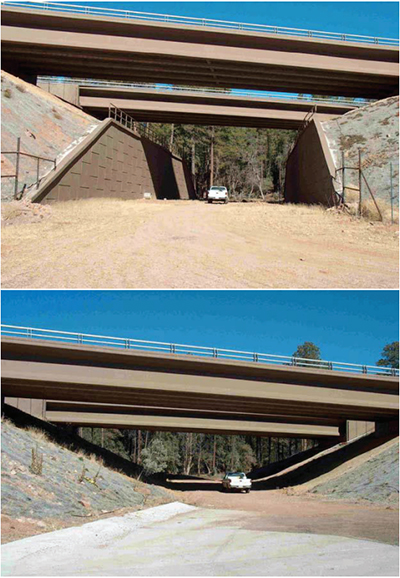
Arizona State Route 260 wildlife crossing bridges with and without retaining walls. Originally published in “The Strategic Integration of Wildlife Mitigation into Transportation Procedures: Practices, Partnerships, and Next Steps.” Photo by T. Brennan |
MnDOT employees can attend a June 23 webinar to learn more about a new manual about including wildlife collision concerns into DOT planning processes.
The manual stems from a five-year Pooled Fund Study project called “Wildlife Vehicle Collision Reduction and Habitat Connectivity.” The Nevada Department of Transportation led the effort. Ten state DOTs, the Federal Highway Administration and several branches of the Canadian government also participated.
The manual is one of the larger deliverable items from this study project, said Christopher E. Smith, wildlife ecologist. It’s an opportunity to incorporate wildlife-vehicle collision concerns into the planning process, and highlight several case studies where this has been done well.
Case studies include:
- The Wildlife Program of the British Columbia Ministry of Transportation and Infrastructure and wildlife protection on British Columbia highways
- The Montana DOT’s work with citizens, agencies and tribal nations to reduce wildlife-vehicle conflicts
- The Colorado DOT and Colorado Parks and Wildlife developing a more comprehensive approach to assist in evaluating potential wildlife-highway mitigation projects
- The Vermont DOT’s staff training and seminars on habitat connectivity as an important consideration in the development of transportation projects
“This manual takes these experiences and makes a framework that other entities, like MnDOT, can use without starting from scratch,” Smith said. “It’s about getting people to think about these things earlier in our processes.”
Animals included in the report run the gamut from salamanders to grizzly bears. No matter the creature, wildlife-vehicle collisions are bad news for everyone involved.
“First, there’s the safety aspect,” Smith said. “Deer-vehicle collisions are common in Minnesota, and we’re one of the top ten states for that. Second, road mortality is one of the leading causes of population decline for some endangered species. Our agency’s vision calls for promoting transportation that maximizes the health of people, the environment, and our economy. Being good environmental stewards is important.”
The webinar meets at 11:30 a.m. Thursday, June 23. No registration is required. Here is the link for the webinar.
|
 |
TABLE of CONTENTS
 |
Leadership Development Program offers professional development opportunities |
By Elizabeth Otto, Workforce Development
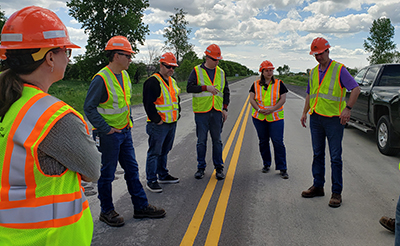
Ben Worel, MnROAD Operations Engineer, (second from left) and Jerry Geib, Research Operations Engineer (in purple T-shirt), instruct Leadership Development Program participants on the research conducted on the low-volume road at the MnROAD facility in Monticello. Submitted photo |
Over the last two years, have you been challenged to work on your skills and professional development?
The Leadership Development Program, coming this fall, offers MnDOT employees an opportunity to build new skills, be more effective in their current roles and advance in their careers.
Open enrollment for LDP’s next sessions, Group 19 and Group 20, runs from Monday, June 20, to Friday, July 22, 2022. Employees can enroll by completing the Commitment Agreement found under the Enroll tab on the newly revised Leadership Development Program iHUB page.
In recent years, LDP-administered training, called Learning Opportunities, were offered entirely online. In Fiscal Year 2023, training will continue to be offered as a mix of online and in-person experiences to suit the schedules and learning preferences of MnDOT employees across the agency.
To learn more about the requirements of the Leadership Development Program, attend an upcoming LDP Lunchtime Info Session. No registration is required for these sessions. Click the Teams link for the session you prefer:
|
 |
|
|
 |
TABLE of CONTENTS
 |
Graduate Trainees learn about STEM outreach |
By Michelle Clark, Office of Human Resources
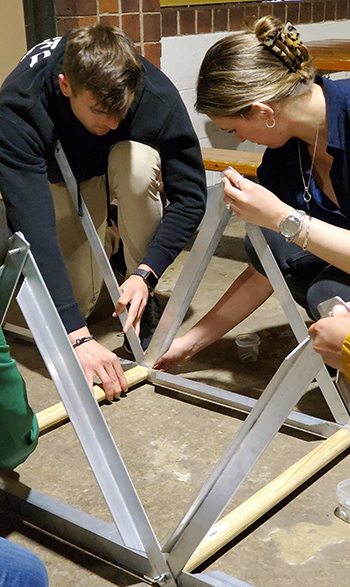
Two Graduate Trainees work on the Bridge-in-a-Bag activity at the Hot Topic meeting in May. Photo by Michelle Clark |
For the last two years, participants in MnDOT’s Graduate Engineer & Land Surveyor conducted their regular Hot Topic meeting in the virtual world. While it gave them time to have a conversation and learn about projects and opportunities, it wasn’t the same as meeting in person. On May 26, 31 Graduate Trainees met with the Graduate Engineer Development Committee at Riverside Pavilion in St. Cloud for the first time since November 2019. The group spent the day learning about STEM outreach activities, participating in team-building exercises, and playing some networking games.
STEM outreach is one way for Graduate Trainees to achieve their required 10 hours of volunteer work. Hands-on classroom activities promote STEM learning and demonstrate the important work MnDOT engineers do. After learning about MnDOT’s activities, resources, and presentation recommendations, the trainees got to try them out by working in teams.
Marcia Lochner, STEM Education and Outreach Program manager, and Nicki Bartelt, GEDC Management Representative, walked the trainees through the resources available for the Bridge-in-a-Bag activity, including how to adapt it for students from kindergarten to high school. Kevin Joyce, Senior Engineer, demonstrated a new highway interchange activity aimed at older high school students. This activity was developed in partnership with HDR and Willow Consulting through their outreach work on the 35W@94: Crosstown to a Downtown project and is currently being tested with students in the Twin Cities metro area. It will soon be available state-wide.
The Graduate Trainees are looking forward to the July Hot Topic meeting, when they will tour the 35W Storm Water Cavern and check out the rehab of the historic 3rd Avenue Bridge in Minneapolis. |
 |
|
| |
 |
TABLE of CONTENTS
 |
On the job: Mina Carlson works to ensure heliport safety |
By Kiran Sjoberg
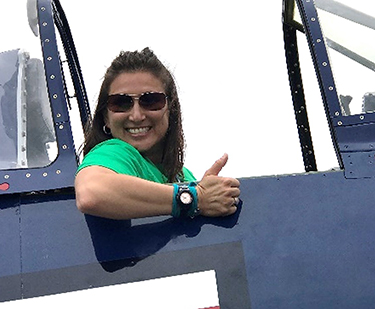
Mina Carlson manages heliports for MnDOT.
Submitted photo |
Mina Carlson, airport program manager of heliports, has worked in MnDOT for two years. Her current role closely aligns with her passion for aeronautics, which brings her gratification and success.
What does your usual workday look like?
My typical workday consists of either an office day or a field day. An office day can consist of touching base with colleagues, getting a feel for where people are with their tasks, doing a debrief with a site owner based on inspections that have been completed, or verifying where heliports are at with being up to date.
On the other hand, a field day can really be anything—it’s a hodgepodge of stuff. For the most part, a field day is meeting with the site owner or doing a thorough inspection on the site itself. Since there are a lot of new construction projects going on through the state, I might go to the site to see where the proposed helipad will be placed and see if there is anything that could hinder future licensing. Sometimes if there is a big project, I like to go to the site frequently to observe the different phases of the project just to ensure that there won’t be any “gotchas.” We like to go out there halfway through the project to check for potential errors that could occur.
Do you have a team that you work with?
I am with the office of aeronautics, which has around 40 people. Specifically, within our office I’m with the airport operations group. There is also a planning group, an engineering group, and a licensing and registration group. All these different groups take on different tasks to make our jobs as efficient as possible.
What is your favorite part about what you do?
I think the favorite part of my job is that there are roughly 5.6 million residents of Minnesota, and we are the people that help them have access to trauma care within the first 45 minutes of a major trauma incident. The most gratifying part of my job is giving those life-support providers access to a safe landing zone so that they can get to that person that needs help in their worst time of need.
Is there anything else that you would like to add?
I think that the office of aeronautics in general is relatively unknown to MnDOT. Our office does a lot of really cool things and there are a lot of moving parts to it. We support so much of our aeronautical community in different facets, and I believe that a lot of the agency just isn’t aware of what we do. I hope that the MnDOT community can gain more exposure to our specific office because it really is an awesome and interesting place.
Mina has just recently returned from a several month deployment leave. Welcome home, Mina! We are so glad to have you back.
Do you or a co-worker have an interesting job to share with readers? Send us your ideas, and we’ll contact you for more information.
Recent employee profiles:
|
| |
|



